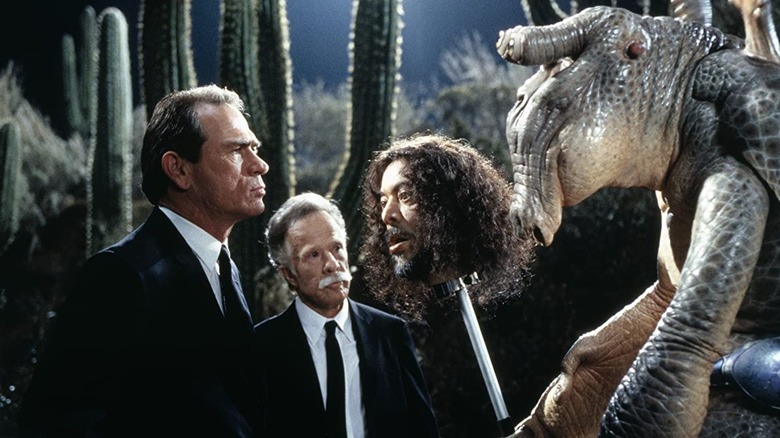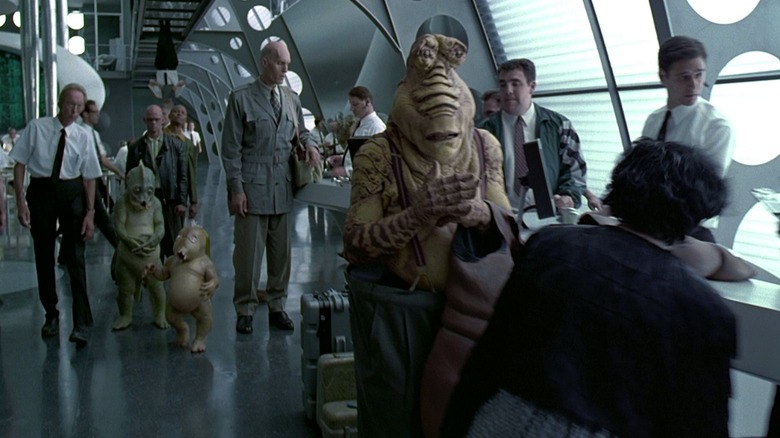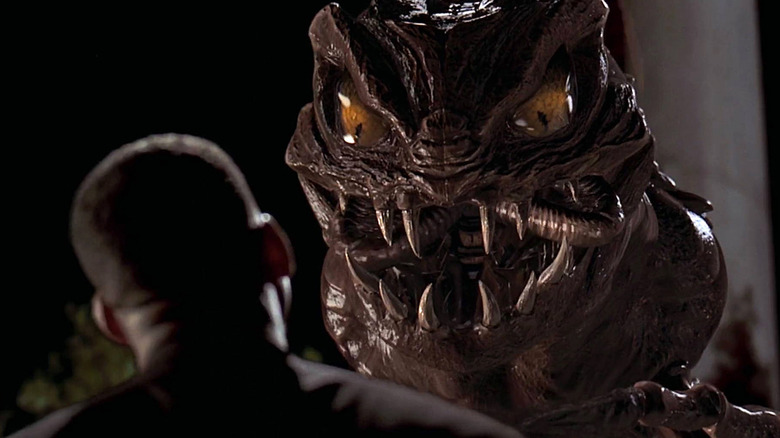Men In Black Built A Million-Dollar Animatronic That Never Made To The Screen
Beginning with the publication of Whitley Streiber's book "Communion: A True Story" in 1987, alien abduction lore began to spread in earnest through the minds of the public. Streiber's book, and the growing popularity of alien imagery, were part of a cultural obsession with extraterrestrial kidnappings which broke open in earnest with the debut of "The X-Files" in 1993. Embedded in the wave of pop alien lore were tales of Men in Black, sinister government agents who wore black suits, ties, and hats, and who would arrive at the doorsteps of alien abductees, hypnotically intoning that they needed to keep their abduction a secret.
By 1997, when Barry Sonnenfeld's hit film "Men in Black" was released in theaters, such previously staid and hushed lore was transformed into broad comedy. "Men in Black" was about, essentially, Earth's immigration office, assembled to document space alien immigrants visiting or moving to our planet. Agents K (Tommy Lee Jones) and J (Will Smith) were given black suits, but also high tech guns, rocket cars, and other fun sci-fi widgets as tools to investigate a giant, Rick Baker-designed cockroach monster from beyond the stars. It was full of creatures and slapstick. It was not at all serious. But like any major film production, making it was seriously business.
The creature in question
In a 2022 oral history of Sonnenfeld's film conducted by Inverse, the director, his production designed Bo Welch, and screenwriter Ed Solomon all discussed the fineries of making "Men in Black," and some of the things they enjoyed — and didn't enjoy — about the process. Like all big studio productions, "Men in Black" was subject to a great deal of studio tinkering, causing no small amount of headaches for the filmmakers.
One of the bigger pains was the special effects required to realize Edgar (Vincent D'Onofrio), the above-mentioned cockroach. Throughout most of the movie, Edgar is a human whose body was taken over by an intelligent bug, and D'Onofrio gives an excellent physical performance. At the end of the film, Edgar hatches out of his human skin to reveal an enormous insect monster. In 1997, CGI technology had advanced enough to animate Edgar with a reasonable amount of realism. It turns out this was a last-minute fix, as Edgar was supposed to be played by a massive, $1 million animatronic. Sonnenfeld, Welch, and Solomon discussed:
Welch: "Barry's on stage, about to have a nervous breakdown, and then they basically rewrote the ending within weeks of shooting it."
Sonnenfeld: "I kept saying, 'We have an action-adventure comedy with very little action and very little adventure.'"
Solomon: "They were originally trying to do it in-camera, puppeted."
Sonnenfeld: "[FX Technician] Rick [Baker] had spent close to $1 million building an animatronic 18- or 20-foot Edgar bug. It could bend but it couldn't walk."
Solomon: "I remember Eric Brevig, who was the visual effects supervisor, saying, 'Guys, you're gonna need to do it in visual effects.'"
Moving to CGI
It turns out that Solomon's original ending for "Men in Black" initially included a lot less flash and whiz-bang, and a lot more "Star Trek"-style philosophizing. Rather than a beat-the-clock-style gun battle that actually ended up in the film, Agent J was to have a conversation with Edgar, discussing the creature's motivations and how fear functions. A conversation with a massive animatronic creature is, as one might imagine, far easier to film than a gunfire-heavy action sequence. David LeRoy Anderson, the film's makeup artist, recalls that Baker was massively unhappy when he learned that his glorious robot was going to be replaced in animation. "They had worked their butts off," Anderson said.
Solomon and Sonnenfeld also recalled the original ending, and how it had been changed. Neither says which ending they preferred:
Solomon: "My ending was probably a little bit more complex than the movie warranted. I always wanted it to be a more philosophical thing."
Sonnenfeld: "That ending was a talk-fest between Will and the Edgar bug about the nature of the universe and about fear. Finally, [producers] Walter [F. Parkes] and Laurie [MacDonald] said, 'Oh my God, you're right. We can't have this ending.; So we realized we were gonna have to add a lot of CG."
The CGI at the climax of "Men in Black" was functional for the time, but still paled in comparison to even more expensive productions like "Titanic" from later the same year, or "Jurassic Park" from four years earlier. While X-Philes and Trekkies and Omni readers might have preferred a quieter, talkier ending, the action climax was better accepted by a mainstream audience. On a budget of $90 million, "Men in Black" made half a billion dollars worldwide.
You will now forget this article. Click on it again.


